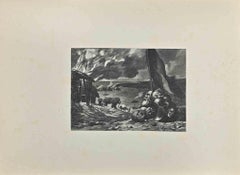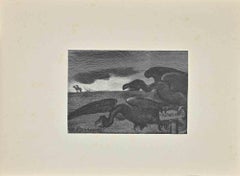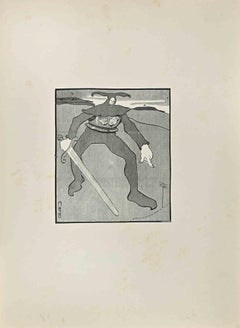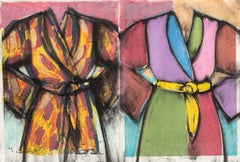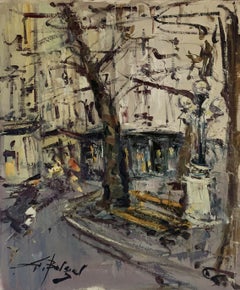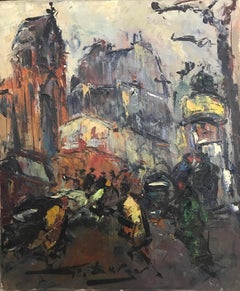Georges Berger Art
to
3
3
3
Shadowing Death - Woodcut Print by Georges Berger - Early 20th Century
By Georges Berger
Located in Roma, IT
Shadowing Death is a woodcut print on paper realized by French artist in 1900s G. Berger.
Signed on the plate on the lower right.
The state of preservation is very good.
The artwork represents the dark scenery of skulls and dead in a dark stormy...
Category
Early 20th Century Modern Georges Berger Art
Materials
Woodcut
Waiting Hyenas - Woodcut Print by Georges Berger - Early 20th Century
By Georges Berger
Located in Roma, IT
Waiting Hyenas is a woodcut print on paper realized by French artist in 1900s G. Berger.
Signed on the plate on the lower right.
The state of preservation is very good.
The artwo...
Category
Early 20th Century Modern Georges Berger Art
Materials
Woodcut
The Warrior - Woodcut Print by Georges Berger - 20th Century
By Georges Berger
Located in Roma, IT
The Warrior is a woodcut print on paper realized by French artist in 1900s G. Berger.
Signed on the plate on the lower right.
The state of preservation is good with slight foxing.
...
Category
Early 20th Century Modern Georges Berger Art
Materials
Woodcut
Related Items
Wedding Party
Located in Buffalo, NY
An original mid century modern woodblock print.
This work is hand signed illegibly and titled "Wedding Party".
Category
1960s Modern Georges Berger Art
Materials
Paper, Woodcut
Winter on Cruise
By Jim Dine
Located in New York, NY
A very good impression of this color woodcut and lithograph diptych. Signed and dated in pencil by Dine. From a limited edition of 12.
Category
Early 2000s Modern Georges Berger Art
Materials
Color, Lithograph, Woodcut
Peace
By Anton Refregier
Located in Fairlawn, OH
Peace
Woodcut printed in orange red ink on japanese paper
Signed and titled in pencil lower right (see photo)
Titled lower left (see photo)
Created along with an illustrated book project Song of Peace, 1950-1959.
Condition: Excellent
Image: 10 1/2 x 4 7/8"
Sheet: 16 1/8 x 7";
Anton Refregier (March 20, 1905 – October 10, 1979) was a painter and muralist active in Works Progress Administration Federal Art Project commissions, and in teaching art. He was a Russian immigrant to the United States.
Among his best-known works is his mural series The History of San Francisco, located in the Rincon Center in downtown San Francisco, California. It depicts the city's history across twenty seven panels that he painted from 1940 to 1948.
Life and early career
Refregier was born in Moscow and emigrated to the United States in 1920. After working various odd jobs in New York City, he earned a scholarship to the Rhode Island School of Design in 1921. After finishing school, Refregier moved back to New York in 1925. To earn a living, Refregier worked for interior decorators, creating replicas of François Boucher and Jean-Honoré Fragonard paintings...
Category
1950s American Modern Georges Berger Art
Materials
Woodcut
No Footprints Show, Where the Flowers Grow Deep
By Shiko Munakata
Located in Fairlawn, OH
No Footprints Show, Where the Flowers Grow Deep
Woodcut, 1961
Unsigned (as isssued)
From: The "Way" of the Woodcut, three woodcuts, 1961
Publisher: Pratt Adlib Press, Brooklyn, New Y...
Category
1960s Modern Georges Berger Art
Materials
Woodcut
By Night On My Bed
Located in New York, NY
Woodcut. Signed by the artist and dated in pencil, lower right. Titled in pencil, lower left, and numbered "28" in pencil, lower center.
This woodcut was made by Esherick to ill...
Category
1920s American Modern Georges Berger Art
Materials
Woodcut
Harvest #2
By Walter Williams
Located in New York, NY
Color woodcut. Signed by the artist in pencil, lower right. Titled "Harvest 2" in pencil, lower center. Numbered "2nd 5/12 Special Edition" in pencil, lower left.
Framed dimensi...
Category
1960s Modern Georges Berger Art
Materials
Woodcut, Color
Walter DuBois Richards, The Lobster Float
By Walter DuBois Richards
Located in New York, NY
Ohio-born Walter DuBois Richards (1907-2006) was educated at the Cleveland School of Art. He re-located to New York around 1933 where he had a successful career as a commercial artis...
Category
1930s American Modern Georges Berger Art
Materials
Woodcut
Oscar Weissbuch, Westchester Hills (NY), New Deal, WPA-era wood engraving
Located in New York, NY
New York City native Oscar Weissbuch (1904-1948), attended the Yale University School of Fine Arts and the Art Students League, NY. He participated in the NYC-WPA printmaking project...
Category
1930s American Modern Georges Berger Art
Materials
Woodcut
John E. Billmyer, Flower Piece, WPA wood engraving
Located in New York, NY
'Flower Piece' shows the artist, John Billmyer, to be a highly accomplished wood engraver. There are endless patterns and created details -- all executed flawlessly. Mostly made up o...
Category
Mid-20th Century American Modern Georges Berger Art
Materials
Woodcut
Dickie (Child in High Chair)
By Will Barnet
Located in Buffalo, NY
An original woodcut on japan paper created by master American artist Will Barnet in 1942.
Category
1940s American Modern Georges Berger Art
Materials
Paper, Woodcut
Dan Burne Jones, Affection
Located in New York, NY
Dan Burne Jones is widely know as the author of the Rockwell Kent print catalogue raisonne. It's so interesting to see that he is a gifted wood engraver as well. Jones's own prints a...
Category
1930s American Modern Georges Berger Art
Materials
Woodcut
Self Portrait-L.B. AET 56
By Leonard Baskin
Located in Fairlawn, OH
Self Portrait-L.B. AET 56
Color woodcut printed in black and green, 1978
Signed in pencil lower right (see photo)
Edition: 150 (97/150)
Condition: Excellent
Image: 32 x 22”
Sheet: 35...
Category
1970s American Modern Georges Berger Art
Materials
Woodcut
Previously Available Items
Mid Century French Post-Impressionist Signed Oil - Montmartre Paris Street Scene
By Georges Berger
Located in Cirencester, Gloucestershire
"Montmartre"
by Georges Berger (French 1908-1976)
signed, lower left
oil painting on canvas, unframed
canvas: 55cm x 46cm
Superb Parisian oil painting...
Category
Mid-20th Century Post-Impressionist Georges Berger Art
Materials
Canvas, Oil
GRAND BOULEVARDS, PARIS
By Georges Berger
Located in Los Angeles, CA
GEORGES BERGER
"GRAND BOULEVARDS, PARIS"
OIL ON CANVAS, SIGNED
FRANCE, C.1940
21.5 X 18 INCHES
Georges Berger
Born 24 January 1908 , in Paris ; died 1976...
Category
1940s Post-Impressionist Georges Berger Art
Materials
Canvas, Oil
Georges Berger art for sale on 1stDibs.
Find a wide variety of authentic Georges Berger art available for sale on 1stDibs. You can also browse by medium to find art by Georges Berger in woodcut print and more. Much of the original work by this artist or collective was created during the 20th century and is mostly associated with the modern style. Not every interior allows for large Georges Berger art, so small editions measuring 12 inches across are available. Customers who are interested in this artist might also find the work of Jacques Beltrand, Felix Labisse, and Eugene Corneau. Georges Berger art prices can differ depending upon medium, time period and other attributes. On 1stDibs, the price for these items starts at $223 and tops out at $312, while the average work can sell for $245.
